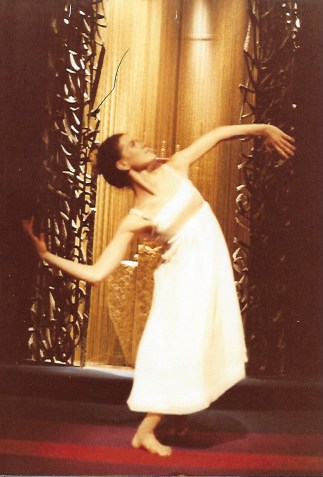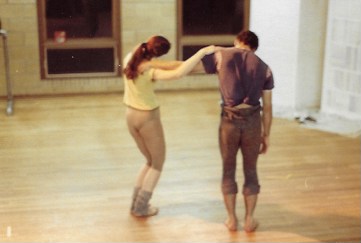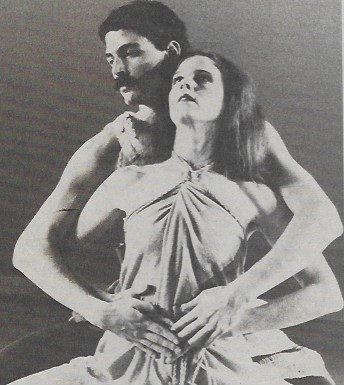Spring 1974. Excited by the strong response to our first piece “In Praise” I am eager to do another piece with Irving that would fit into the Sabbath Service. Having a limited education in liturgy, I find myself reading and learning as much as I can. I zero in on the Friday night candlelighting gesture of circling the flames and covering the eyes. What does it mean? Where did it come from? I start experimenting, myself, with using the gesture when I light the candles. (Now… to be upfront, I was not very observant and it was as much out of curiosity as any kind of spiritual desire or need that I found myself lighting the candles and saying the blessing on Friday night.)
I soon showed Irving the gesture, with much enthusiasm, one early evening in his backyard. We decided to move forward on creating a piece related to welcoming the Sabbath. Research continued with the help of Rabbi Garfein. In fact, we dedicated the first performance, November 9, 1974 to him. That was also the first official performance of The Avodah Dance Ensemble, a part of the newly formed Avodah, Inc. (See this earlier blog to learn more about this.)
As Irving and I researched the idea of welcoming the Sabbath the piece began to take shape into several sections. Its opening was expressed in a statement we wrote about the piece for the first performance: “The image of Women, be she Mother, Daughter, or Grandmother, with eyes covered, praying over the Sabbath lights, while her family silently gathers around, inspired the dance and music of our new piece.”
I found the gesture of circling the flame and covering the eyes to be a very personal one and I imaged that each person did it in their own way with their own thoughts. The piece opens with three women each doing the gesture in their own way and conveying their emotional response in movement. They come together doing circular movement putting the hand gesture into the whole body and the feet. As I choreographed I realized I was drawing on my composition classes with Louis Horst in making sure each movement related to the theme I had introduced. Helen Tamiris’s use of gesture as a starting point was also a key influence. Long after the piece was no longer a part of the repertory, we often included the movement ritual of circling and covering the eyes as part of workshops. Kezia has said about this, “In all the years I was in the company, I always loved and was intrigued by workshop participants’ explanations of how precisely they did the candlelighting gesture, where they had learned it, and what they thought of when doing it.”
In our research we learned that the Sabbath is often referred to as a bride and that a 16thcentury hymn still used in most services, “Lecha dodi likras kallah” expresses the notion of embracing the Sabbath as a bride and even of men dressing as a bridegroom going out to welcome the Sabbath. As our piece evolved we introduced a dancer as the bride and a male dancer to embrace her in a duet.
Many years later, living in the New York area, I occasionally enjoyed attending Friday night services at B’nai Jeshurun and there following “Lecha dodi” congregants fill the aisles with joyful dancing. But that was not at all what I grew up with and while some communities have begun to do this it is still pretty rare, at least in the United States.
So on Friday, November 9ththe Avodah Dance Ensemble gave its first official performance. The company consisted of five dancers. Judith Bloomberg, Hillary Gal and I opened as the three women. Corrine Levy was the bride with Jack Clark representing the bridegroom or man who greets the Sabbath.

Hillary Gal and I rehearsing “Sabbath Woman.” Photo by Tallahassee Democrat.
Living in Tallahassee near Florida State University’s excellent dance department I was able to draw dancers from there and take classes to keep myself in shape. Dr. Nancy Smith, the head of the FSU dance department, was very welcoming and even helped by providing rehearsal space.
Reflecting back on those first few years in Tallahassee I realize I had come a long way from the first year as a faculty wife when I felt alone, unable to find a job. In fact in an article in the Tallahassee Democratdated September 1, 1974 I am quoted as saying “It was really bleak. I couldn’t find a job. Nothing happened for a year, and I was going berserk.”
I did focus on writing my dissertation, and I was lucky that my major professor had moved from the University of Wisconsin to Florida State University’s Drama Department. I was able to return to the University of Wisconsin and defend my dissertation in 1973 officially becoming Dr. Tucker. Now there were two Dr. Tucker’s in our household, Murray with his Ph.D. in Economics and I with mine in Theatre/Speech Communication.
I was also learning how to create my own opportunities and by the fall of 1974 I felt totally a part of the community with various dance projects besides Avodah and plans underway to build my own dance studio.
 Print This Post
Print This Post
Links to Recent Blogs
- The Pioneers of Modern Dance: My Firsthand Experience
- A Visit to a Costa Rican Art Museum Triggers a Fascination with Mascaradas
- Thoughts after Streaming a Memorial for Dance Critic Jack Anderson
- Keeping Up With What is Happening in the Dance World
- A Sijo Poem for the Winter Solstice
- Episode 33: The Universal Dancer Podcast – I’m Interviewed by Leslie Zehr
- The National Symphony of Costa Rica
- Can you go home again?
- Odd Thing to Find on eBay
- Chopping in the Kitchen

 Regina Ress is an award winning storyteller, actor, author, and educator who has performed and taught from Broadway to Brazil, in English and Spanish, in settings from grade schools to senior centers, prisons to Carnegie Hall, homeless shelters to The White House. She teaches applied storytelling at NYU and produces a long-running storytelling series at NYU’s Provincetown Playhouse. She is a founding Board member of Healing Voices-Personal Stories.
Regina Ress is an award winning storyteller, actor, author, and educator who has performed and taught from Broadway to Brazil, in English and Spanish, in settings from grade schools to senior centers, prisons to Carnegie Hall, homeless shelters to The White House. She teaches applied storytelling at NYU and produces a long-running storytelling series at NYU’s Provincetown Playhouse. She is a founding Board member of Healing Voices-Personal Stories. 





























